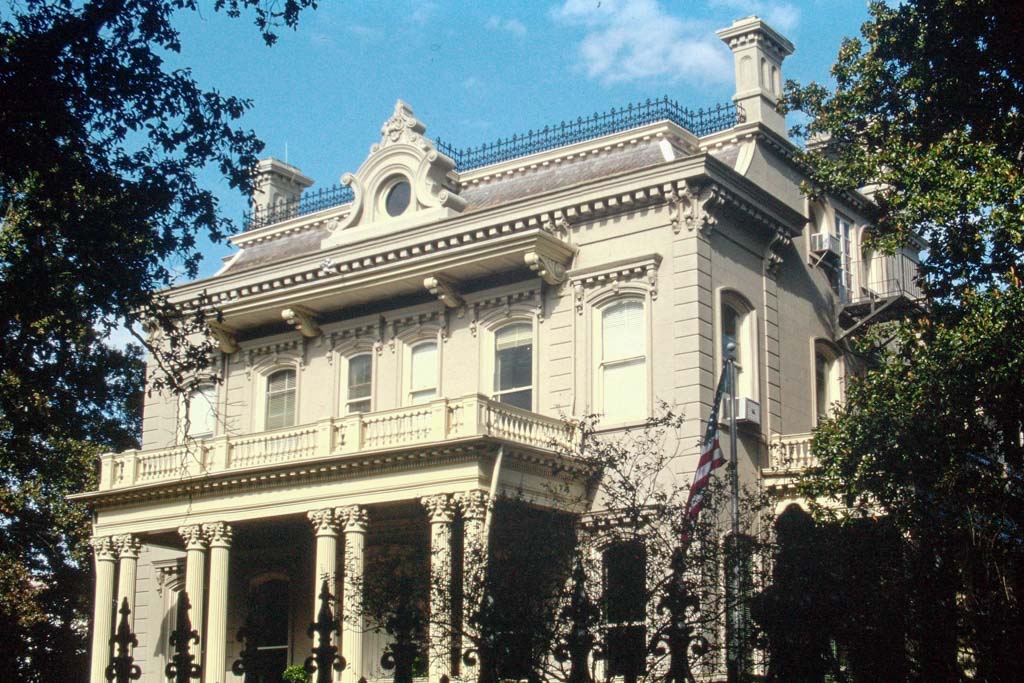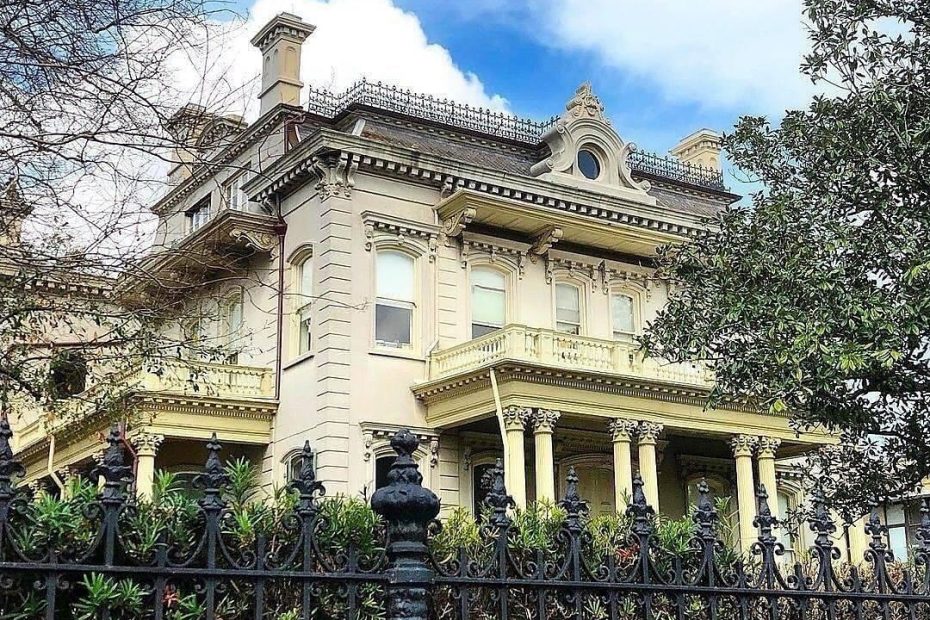The Bradish Johnson House, built in 1872, is a notable example of historic architecture in New Orleans. Located in the Garden District, this house exemplifies the Italianate style that was popular in the U.S. during the mid-19th century. The Italianate style is characterized by its ornate detailing, such as decorative brackets under the eaves, arched windows, and a low-pitched roof.
New Orleans’ Garden District is renowned for its well-preserved historic mansions and their lush gardens, reflecting the city’s opulent past and the influence of different architectural styles that have graced the area. The Bradish Johnson House adds to the district’s rich architectural tapestry, contributing to its charm and historical significance.

The Bradish Johnson House, built in 1872, has a rich history that reflects the opulence and cultural shifts of post-Civil War New Orleans. Here are some key points about its history:
Architectural Style: The house is designed in the Italianate style, which was popular in the United States during the mid-to-late 19th century. This style is characterized by its use of elaborate ornamentation, including cornices, brackets, and arched windows, as well as a strong emphasis on vertical lines and asymmetrical shapes.
Bradish Johnson: The house was built for Bradish Johnson, a prominent businessman and one of the early investors in the New Orleans cotton industry. His wealth and status were reflected in the grandeur of the home. Johnson was influential in the economic development of New Orleans during a period of significant growth and transformation for the city.
Historical Context: The construction of the house in 1872 came at a time when New Orleans was recovering from the Civil War and the effects of Reconstruction. The city’s economy was beginning to rebound, and the Garden District, where the Bradish Johnson House is located, was an area of affluence and development.
Garden District: The Garden District itself is a historic neighborhood known for its well-preserved antebellum mansions and lush gardens. It was developed in the 19th century as a wealthy residential area, with many of the homes, including the Bradish Johnson House, reflecting the prosperity of their original owners.
Cultural and Historical Significance: Over the years, the Bradish Johnson House has witnessed many changes in the city. It stands as a testament to the architectural and cultural heritage of New Orleans, embodying the style and elegance of a bygone era.
The Bradish Johnson House, like many historic properties in New Orleans, contributes to the city’s rich tapestry of history and culture, reflecting both the grandeur and the challenges of its time.

Exploring the Elegance and History of the Bradish Johnson House
Nestled in the heart of New Orleans’ historic Garden District stands the Bradish Johnson House, an architectural gem that has witnessed over a century of the city’s rich tapestry. Built in 1872, this magnificent residence is a shining example of the Italianate style that defined the opulent aesthetics of post-Civil War America. Its grandeur and historical significance offer a window into both the architectural trends and the social dynamics of the time.
Architectural Brilliance
The Bradish Johnson House is a prime specimen of the Italianate architectural style, which was embraced in the United States during the mid-19th century. Characterized by its elaborate ornamentation, the house features a striking façade adorned with decorative brackets, arched windows, and a low-pitched roof. The vertical lines and asymmetrical shapes typical of the style are executed with a meticulous attention to detail, showcasing the craftsmanship and design sensibilities of the era.
A Man of Influence
The residence was constructed for Bradish Johnson, a prominent businessman and a key figure in the New Orleans cotton industry. Johnson’s success in the burgeoning post-Civil War economy enabled him to commission a home that reflected both his wealth and his status. His investment in the cotton trade was instrumental in revitalizing New Orleans’ economy during a period of reconstruction and growth.
Historical Context
The Bradish Johnson House was built at a pivotal moment in New Orleans’ history. In the wake of the Civil War, the city was navigating the complex waters of Reconstruction, and its economy was in the midst of a transformation. The Garden District, where the house is located, was emerging as a symbol of affluence and progress. The neighborhood, known for its lush gardens and grand mansions, was becoming a haven for the city’s elite.
The Garden District
The Garden District itself is renowned for its architectural beauty and historical significance. Developed as a wealthy residential area in the 19th century, it boasts a collection of well-preserved antebellum homes and manicured gardens. The Bradish Johnson House fits seamlessly into this historic landscape, contributing to the district’s reputation as one of New Orleans’ most charming and visually stunning neighborhoods.
Legacy and Preservation
Over the years, the Bradish Johnson House has stood as a testament to the elegance and prosperity of its time. Its continued preservation reflects the broader efforts to maintain and honor New Orleans’ architectural heritage. As the city evolves, landmarks like the Bradish Johnson House serve as crucial links to its past, offering insights into the lives and aspirations of those who shaped its history.
Conclusion
The Bradish Johnson House is more than just an architectural marvel; it is a symbol of New Orleans’ resilience and grandeur. As one of the many historic residences in the Garden District, it encapsulates the spirit of an era marked by transformation and growth. For historians, architecture enthusiasts, and visitors alike, the house remains a cherished piece of the city’s rich heritage, standing as a reminder of the elegance and ambition that defined 19th-century New Orleans.

